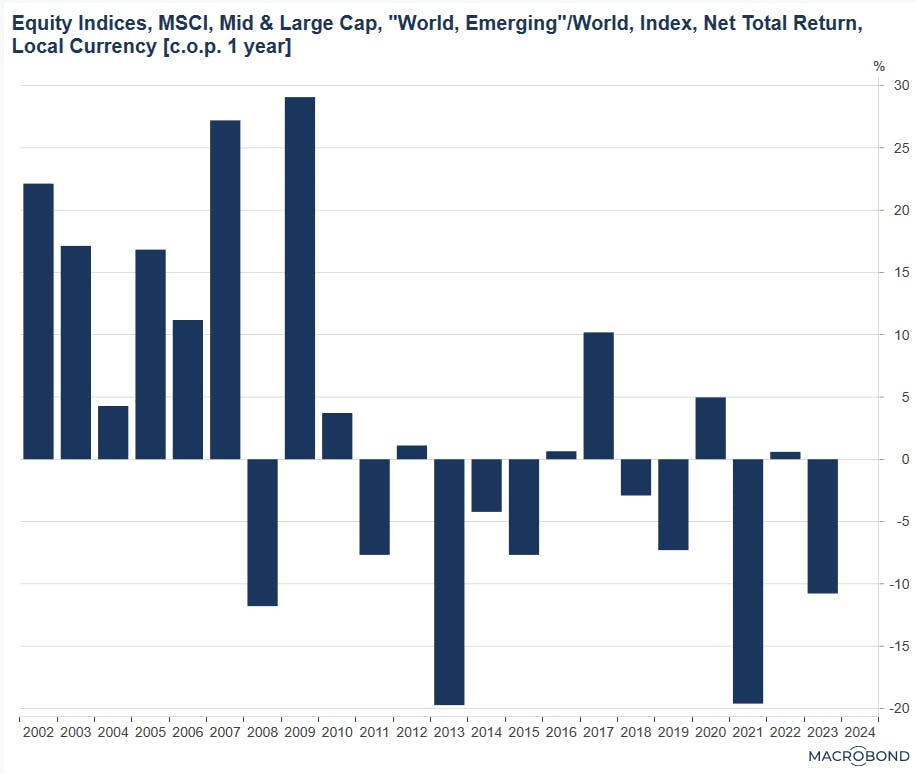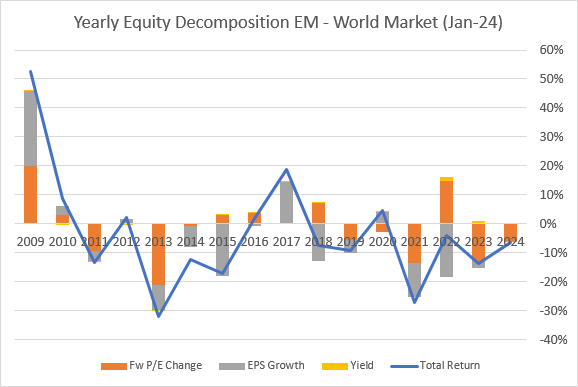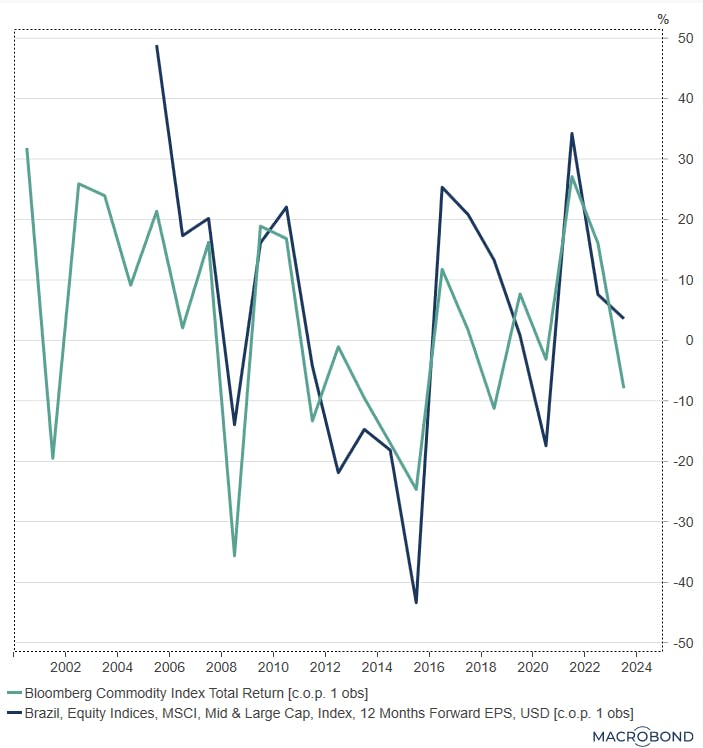
Since 2009, emerging market equities have lagged behind their developed market peers. Why is this the case? And what does it mean for investors going forwards? We look at the story behind the data.
At a glance
- Historically, investors may have expected emerging market (EM) equities to outperform developed market (DM) equities
- This expectation is based on economic theory and risk-reward: investors want compensation for taking on the risk of investing in EMs
- Since 2009, EM equities have on aggregate underperformed their developed market peers, forcing investors to revise their expectations, and the theories they are based on
- Company earnings have disappointed, and EMs' greater sensitivity to global macroeconomic forces combined with the structure of their domestic economies has been a headwind to performance
- Going forwards, the outlook for EMs is uncertain, with further challenges on the horizon
Historically, investors have looked to emerging markets for cheaper but potentially higher risk stocks that offer the possibility of greater returns. Why is that? Well, it all rests on the promise of 'convergence'.
Convergence is the idea that incomes of citizens of emerging economies tend to grow at faster rates than those in richer, more mature economies. Much of this comes down to the potential for faster growth in manufacturing, employment, and money flow from developed markets, all factors which can support the performance of emerging market equities.
Convergence also rests on the concept of diminishing returns to capital investment. This means that as an investment in a particular area increases, the rate of potential profit from that asset – up to a certain point – cannot also increase. Farmland is the classic analogy here: once you exhaust the land available in a given plot, rather than planting more seeds in the same plot, you’re best going to other plots with plenty of nutrients to increase income.
The same principle here underpins capital inflows to emerging economies. The average investor may gain better returns by investing in markets with a lower capital to labour ratio (the amount of capital available per worker), as the marginal return on capital will be higher where the ratio had a low base to begin with, compared with the amount of capital available. This should, in theory, enable EM equities to outperform their developed market peers.
This return should in theory show up in equity markets as outperformance in emerging markets versus developed markets. On balance, however, investors should require a higher return on EM assets than developed assets due to the higher risk from factors such as illiquidity (illiquid assets are harder to sell if there are fewer buyers) and currency volatility (EM currencies are generally deeply affected by strong currencies like the US dollar, and can be prone to sudden devaluation).
Convergence is what we saw with the Asian Tigers (South Korea, Taiwan, Hong Kong, Singapore) in the latter part of the 20th century (1), in the Baltics in Europe in the early 2000s (2) and, more importantly, this is reflected in the MSCI Emerging Markets Index in the 2000s.
Over the past 15 years, this narrative has not played out, leading some to re-think the convergence theory. One school of thinking is that higher returns can only be realised if there are structural changes to bring emerging market economies in line with more advanced economies.
But there's more to this story. There appears to be a clear divergence in the fortunes of emerging market economies pre and post-2010, as demonstrated in the chart below.
Chart 1: Emerging market performance 2002-2024, local currency terms

Source: Macrobond
This tells us the story of underperformance numerically – but we can go further and examine the sources of underperformance, and look at why EMs have struggled over the past 15 years.
We use here the Grinold-Kroner Model.
Very simply, the model allows us to break down returns into components: yield, forward price-to-earnings ratio, repricing, and earnings growth.
- Yield is the return earned by way of dividends or stock buybacks
- The forward price-to-earnings (FW P/E ratio) divides the company's share price by its estimated future earnings per share – and changes in the FW P/E ratio impact repricing (the price of a stock going up or down), driving returns
- Earnings growth (Earnings Per Share growth) reflects the changes, either positive or negative, in how much companies earn each year
The combination of all three gives a fuller picture of how much return is earned, and where it’s coming from. This is even more useful as we can not only look at the differences in returns but we can also identify and isolate exactly which component is contributing to the differences in return between different markets.
Chart 2: Composition of emerging market equity returns, 2009-2024, USD

Source: Macrobond
This breakdown provides a good amount of insight into EM indices as a whole.
We see there’ve been periods of repricing action in the orange bars where forward P/E moves sharply downwards (2013, as an example). Zooming out a bit however, we see one persistent contributor to the underperformance of EM markets: lower earnings growth in the grey bars that appears in the majority of the years since 2010.
Looking local: what the performance of different emerging markets tells us
The MSCI Emerging Markets Index comprises 24 emerging markets. Here, we focus on the story of Brazil, India, China, South Korea and Taiwan.
For much of the period, these five countries comprised a chunky 65% to 80% of the MSCI Index.
As we'll see, EM equity markets tend to be dominated by sectors and in some cases, individual companies. Over the past 15 years, this has had a positive and negative impact on their performance.
Generally speaking, EMs are also very sensitive to the winds of global factors compared with larger, more diversified economies which generate much of their returns domestically. We can explore just how sensitive they are to macroeconomic forces via correlation analysis, which involves comparing emerging markets to global aggregate indices. While it's important to note that these are explicitly not determinants of returns, they nevertheless present interesting datapoints as food for thought.
We run correlation analysis below on semi-annual returns data for the indices referred to below. Correlation numbers are interpreted on a scale of -1 to 1. Correlations of less than 0 are negatively correlated, around 0 is no correlation (indicating a low sensitivity to global factors) and greater than 0 is positive correlation (indicating a high sensitivity to global factors).
Do not ignore commodities: Brazil and India
Brazil and its equity markets have been incredibly sensitive to shifts in global demand for commodities (including coffee and sugar). The early 2000s saw a commodities boom unleashed by China’s ascension to the World Trade Organisation. Brazil was a major beneficiary of China's increased demand for commodities (3), with its largest exports shifting from 24.6% to the US (in 2001) to 14.7% to China in 2010. Running correlation on an annualised basis, we see a correlation between the Bloomberg Total Return Commodities Index and MSCI Brazil's EPS growth component of returns running at a strong level of 0.68. In the chart below, we see how Brazil's equity indices have moved in line with the commodity market, noting their volatility in recent years.
Chart 4: Performance of commodities and Brazilian equities, 2002-2024, USD

Source: Macrobond
India has also been sensitive to global shifts, but here we look at the correlation data a little differently. Bearing in mind the cause of its initial slowdown including a hangover from the 2009 global financial crisis and the ensuing growth slow down, a depreciating currency, a return of higher inflation and accompanying higher interest rates. While it's readily accepted by most commentators that the economy of Brazil is intricately linked to commodities, India is much more spoken of in the context of its pharmaceuticals and information technology sectors.
However, income from agriculture still remains important in any analysis of India, and when we correlate the MSCI India EPS growth each year with the Bloomberg Total Return Commodities index, we see a high correlation of 0.58.
The story of India appears to be peeling away from its decade-long narrative in recent times, as investors pull back from China in search of exposure with less regulatory and geopolitical risk.
Taiwan and South Korea: Information Technology is a key driver
Taiwan and South Korea are quite driven by the fortunes of information technology.
At the time of writing, Taiwan Semiconductors (TSMC) is about 24% of MSCI Taiwan, and Samsung contributes 21% to MSCI South Korea (4). All in, we see a total contribution by Information Technology (IT) of 61% to MSCI Taiwan and 33% to MSCI South Korea (5). But how much does the global market’s view of information technology actually gets reflected in each economy?
Again, we ran a correlation analysis on the returns of each index against MSCI AC World Information Technology Index, and saw a very moderate correlation of 0.50 for MSCI Taiwan and low correlation of 0.42 for MSCI South Korea (6). This low to moderate correlation means that the performance of global information technology indices is reflected to some degree in Taiwan and South Korea's local stock indices (7).
China: Materials is important for the scale up of an economy
There’s been much research and analysis carried out in recent years on the importance of a rapidly evolving geopolitical landscape, from the introduction of tariffs, changing domestic and foreign regulatory landscape, to changing internal focus within China.
But, as in the other emerging markets, the underperformance of Chinese EPS growth began much earlier, with underperformance beginning in 2011. Since then, China's economy, including its property sector, has faced battles with inflation, increasing interest rates, a change in focus from export-oriented output to growth led by domestic demand too, and most recently, an embattled real estate sector.
We, however, look for insight into China’s equity markets via sector-based analysis. China’s growth story cannot be separated from its materials and accordingly, we see a strong correlation of 0.52 between MSCI AC World Materials and MSCI China EPS growth. Materials and China are closely linked, as materials act as the fuel powering the growth of other sectors, including infrastructure, industry and real estate. This serves as a reminder that however damaging the impact of the property crisis in China, investors should look beyond it to examine the knock on effects on other sectors. It's also worthwhile to not only look at the internal factors affecting its domestic economy but external and global factors as well.
What is the outlook for emerging markets?
Emerging markets are clearly a diverse group, with very many factors and drivers influencing their economies and their equity markets.
There are some notable headwinds ahead for the major emerging economies. First, a goodbye, perhaps, to the global low interest rates regime we saw post-2009. Second, the reduction in demographic advantages as economies stop growing, third, a slowdown in institutional reforms that lead to convergence and finally, the ever present geopolitical risk and the influence of external variables like the US Dollar. There are also potential tailwinds: the global green transition that could drive demand for green commodities and materials, boost information technology and change the nature of demand fundamentally.
We’ll round off returning to the original premise therefore with the recognition that convergence and the realisation of a higher equity market return (as a result of a higher relative marginal return to capital) isn’t a straightforward path.
Global headwinds, as well as domestic equity market dynamics, can temporarily derail the journey. We continue to monitor the investment case for emerging markets, and we maintain an underweight position in our portfolios.
Sources
(1) https://en.wikipedia.org/wiki/Four_Asian_Tigers
(3) https://oec.world/en/profile/country/bra?yearSelector1=2001
(4, 5) Bloomberg
(6) The US constitutes the largest country allocation to the Information Technology Index at 88.46% as of Dec 2023 https://www.msci.com/documents/10199/69aaf9fd-d91d-4505-a877-4b1ad70ee855
(7) MSCI ACWI - annual returns of 51.5% 2023, MSCI Taiwan - annual returns of 31.33% in 2023 - https://www.msci.com/documents/10199/6f36d84d-425d-4e1f-8d56-e65c455ebda1, https://www.msci.com/documents/10199/aa4a6b46-4e72-45af-8d1b-5c8f00459666
All correlation data is from Macrobond.
Risk warning
Emerging markets are riskier than developed markets because they can experience political instability, illiquidity and currency volatility, and a high level of state-owned or state-run enterprise and are not suitable for all investors. As with all investing, your capital is at risk. The value of your portfolio with Nutmeg can go down as well as up and you may get back less than you invest. Past performance and simulated past performance are not a reliable indicator of future performance. Forecasts are not a reliable indicator of future performance.
